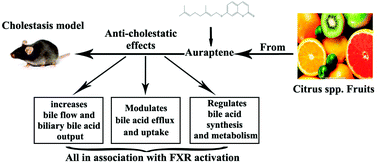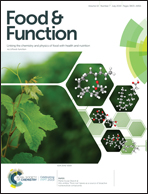Hepatoprotection of auraptene from the peels of citrus fruits against 17α-ethinylestradiol-induced cholestasis in mice by activating farnesoid X receptor
Abstract
Cholestatic liver injury induced by estrogen is a common clinical syndrome in women undergoing oral administration of contraceptives, pregnancy or hormone replacement therapy. Estrogen-induced cholestasis is associated with the accumulation of endogenous bile acids, which play critical roles in the disease progression and symptoms. In the present study, we described the protective effect of auraptene, a simple coumarin present in the peels of citrus fruits, such as grapefruit, against 17α-ethinylestradiol (EE)-induced cholestasis, and further elucidated the involvement of farnesoid X receptor (FXR) in the hepatoprotective effect. Auraptene treatment alleviated EE-induced cholestasis through increasing the bile flow and biliary bile acid output. The mechanism underlying the alleviated cholestasis by auraptene was associated with the increased efflux and inhibited hepatic uptake of bile acids via an induction of efflux transporters (Bsep and Mrp2) and downregulation of Ntcp. Furthermore, auraptene reduced the bile acid synthesis through repressing Cyp7a1 and Cyp8b1, and increased the bile acid metabolism through an induction in the gene expression of Sult2a1. The mentioned genes involved in the bile acid homeostasis were modulated by FXR. We further demonstrated that the changes in transporters and enzymes, as well as ameliorated liver histology by auraptene, were abrogated by the FXR antagonist guggulsterone. In conclusion, auraptene alleviated EE-induced cholestasis due to FXR-mediated gene regulation.



 Please wait while we load your content...
Please wait while we load your content...